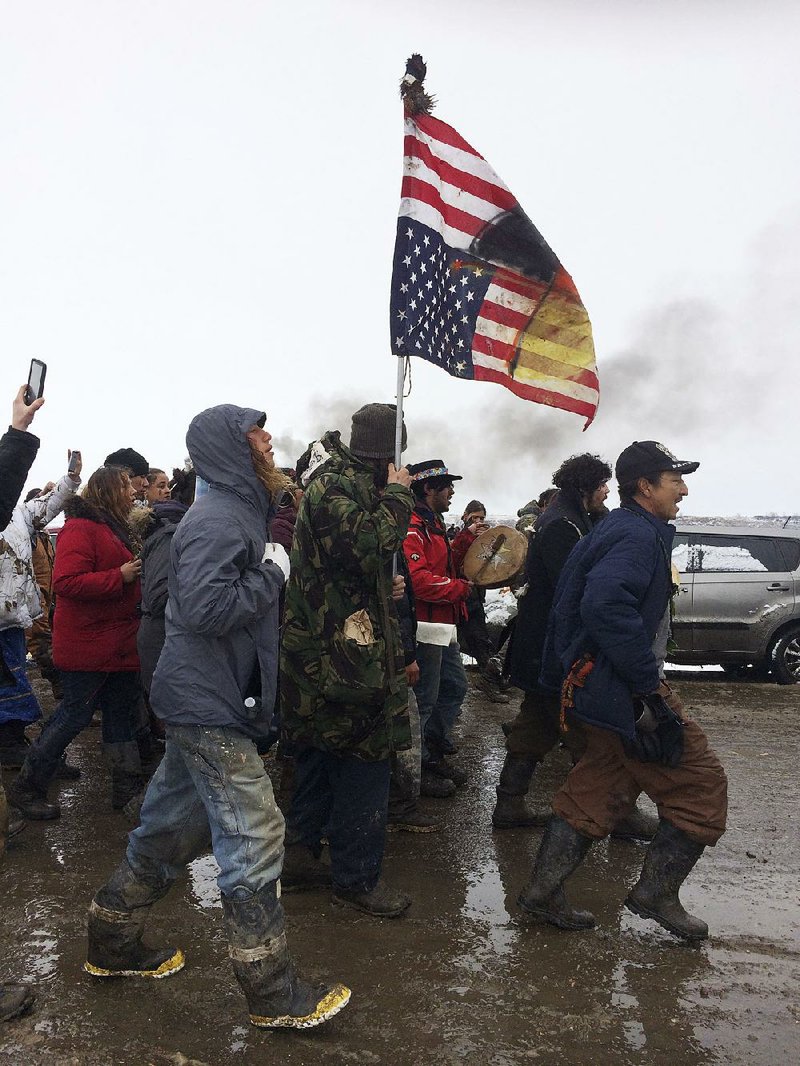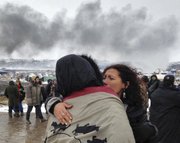CANNON BALL, N.D. -- Most of the Dakota Access pipeline protesters abandoned their camp Wednesday ahead of a government deadline to get off the federal land, and authorities moved in to arrest those who defied the order.
The camp has been home to demonstrators for nearly a year as they sought to thwart construction of the pipeline. Many of the protesters left peacefully, but police began making arrests two hours after the deadline.
As part of a leaving ceremony earlier in the day, occupants set fire to some of the camp's makeshift wooden housing. Authorities later said about 20 fires were set, and two people -- a 7-year-old boy and a 17-year-old girl -- were taken to a Bismarck hospital to be treated for burns. Their conditions weren't given.
After the deadline passed, as many as 75 people outside the camp started taunting officers, who drove five large vans to the scene. Police took at least nine people into custody for failing to heed commands to leave, authorities said.
With darkness falling, Lt. Tom Iverson said police would not enter the camp Wednesday evening, and he offered no timetable for doing so.
Levi Bachmeier, an adviser to Gov. Doug Burgum, said about 50 people remained in the camp at dusk Wednesday.
Hours before, about 150 people marched arm in arm out of the soggy camp, singing and playing drums as they walked along a highway. It was not clear where they were headed. One man carried an American flag hung upside down.
Authorities sent buses to take protesters to Bismarck, where they were offered fresh clothing, bus fares home, and food and hotel vouchers.
The U.S. Army Corps of Engineers set the deadline, citing the threat of spring flooding.
At the height of the protests, the site known as Oceti Sakowin hosted thousands of people, though its population dwindled to just a couple of hundred as the pipeline battle moved into the courts.
The camp is on federal land in North Dakota between the Standing Rock Sioux Reservation and the pipeline route that is being finished by Dallas-based Energy Transfer Partners. When complete, the project will carry oil through the Dakotas and Iowa to a shipping point in Illinois.
The Standing Rock Sioux tribe has argued that a stretch of the $3.8 billion pipeline threatens its water supply, crosses burial grounds and violates treaties between Americans Indians and the federal government.
President Donald Trump has supported the project and ultimately cleared the way for it. He signed an order aimed at expediting the pipeline's approval before his administration approved final permits needed to complete it. The move came as Standing Rock Sioux Chairman David Archambault II arrived in Washington ahead of a scheduled White House meeting, leading him to say: "I think that I was set up."
A federal judge has left open the possibility of further court intervention, and the company behind the pipeline has said that oil could flow within 30 days.
The Standing Rock Sioux tribe said Wednesday morning that it was closely monitoring law enforcement activity at the camp and called on "everyone to remain peaceful."
Some of the protesters Wednesday were focused on moving off federal land and away from the flood plain into other camps, said Phyllis Young, one of the camp leaders.
"The camps will continue," she said. "Freedom is in our DNA, and we have no choice but to continue the struggle."
New camps were popping up on private land, including one the Cheyenne River Sioux set up about a mile from the main camp.
"A lot of our people want to be here and pray for our future," tribal Chairman Harold Frazier said.
Others, including Dom Cross, an Oglala Sioux from Pine Ridge, S.D., said he planned to return home after living at the camp since September.
"There's a lot of sadness right now. We have to leave our second home," he said.
Law enforcement officers and first-responders were on hand from several states.
Charles Whalen, 50, an alcohol- and drug-abuse counselor from Mille Lacs, Minn., said he and a group of about 20 people were not going to leave on their own and were willing to get arrested to prove their point.
"Passive resistance," Whalen said. "We are not going to do anything negative. It's about prayer."
Some campers said they were leaving with mixed feelings, both energized by the long protest and saddened to leave new friends. Some people set off fireworks.
Matthew Bishop of Ketchikan, Alaska, has been in North Dakota since October. He planned to move to another camp.
"People have been surviving here for hundreds and hundreds of years ... so if I back down, what would I look like?" Bishop said as he tied his possessions to the top of his car.
Craig Stevens, spokesman for the Midwest Alliance for Infrastructure Now coalition of agriculture, business and labor interests, said the group understands "the passions that individuals on all sides of the pipeline discussion feel" and hopes that protesters' voices "will continue to be heard through other peaceful channels and in court."
An effort to clean up the camp has been underway for weeks, first by protesters themselves and now with help from the Corps of Engineers in removing debris.
Some vehicles and pedestrians were having trouble getting through the muck created by recent rain and snow, and cleanup efforts were suspended in part because camp officials did not want heavy equipment making conditions worse.
Information for this article was contributed by Blake Nicholson and James MacPherson of The Associated Press; and by Mark Berman of The Washington Post.
A Section on 02/23/2017

